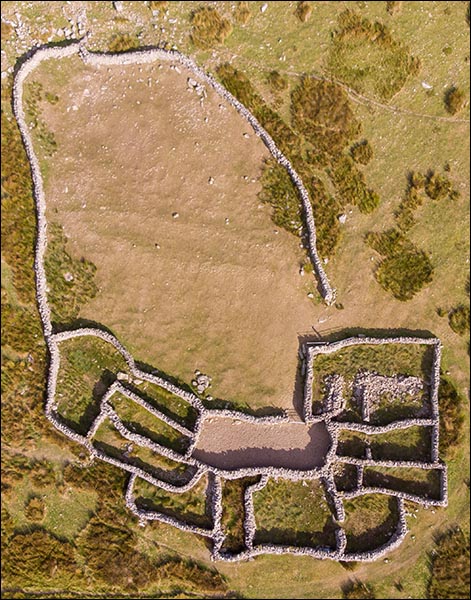Buarth Ro-Wen sheepfold
This multi-cellular sheepfold is one of many in the Carneddau area of Eryri (Snowdonia) where sheep from the mountain slopes are gathered and sorted at specific times of the year
It sits near the entrance to Cwm Caseg 445 metres above sea level. Its name refers to a place where there is gravel. It is also known locally as Buarth Fron-Wen. In Welsh, 'corlan' is the word generally used to refer to an enclosed space for keeping sheep, but, in the Carneddau area, 'buarth' is often used when referring to gathering pens.
 A large proportion of the Carneddau is unenclosed common grazing land, where sheep from different farms mingle during the spring and summer months. Farmers collectively gather all of the sheep into the sheepfolds three times a year: in July for shearing; in September for separating lambs from the ewes; and in October or November when the sheep are brought down to the lower ground for the winter.
A large proportion of the Carneddau is unenclosed common grazing land, where sheep from different farms mingle during the spring and summer months. Farmers collectively gather all of the sheep into the sheepfolds three times a year: in July for shearing; in September for separating lambs from the ewes; and in October or November when the sheep are brought down to the lower ground for the winter.
These multi-cellular sheepfolds are communal, and like many others, Buarth Ro-Wen is still in use today. It has 14 cells, including the large gathering cell at the top, where the sheep are driven ready to be sorted into the individual cells assigned to each farm. Farmers identify the sheep by the coloured markings on their backs or by their 'clustnodau' (cuts in the ears which are unique to each farm) and drive them through creeps (holes in the internal walls) into the smaller cells at the bottom.
Stray sheep, sheep that do not belong to any of the farms that use the sheepfolds, are returned to their owners by the chief shepherd, or 'setiwr'. This name is derived from the English word 'escheater', a royal official in mediaeval times whose job was to claim assets for the Crown when a person died without any heirs.
The oldest sheepfolds of the Carneddau date from around the 18th century, when large estates and wealthy individuals began to enclose the common land on the mountains. Sheep replaced cattle as the main grazing animals on the Carneddau as they were more profitable, especially when the demand for sheep’s wool and meat increased during the Napoleonic wars 1800-1815.
Buarth Ro-Wen was shown on a map dated 1786 and was probably built sometime in the 100 years before this.
With thanks to Nigel Beidas of Cofnodi Corlannau
Grid reference: SH 65728 66944 View Location Map
Website of Cofnodi Corlannau – details and photos of the Carneddau sheepfolds

